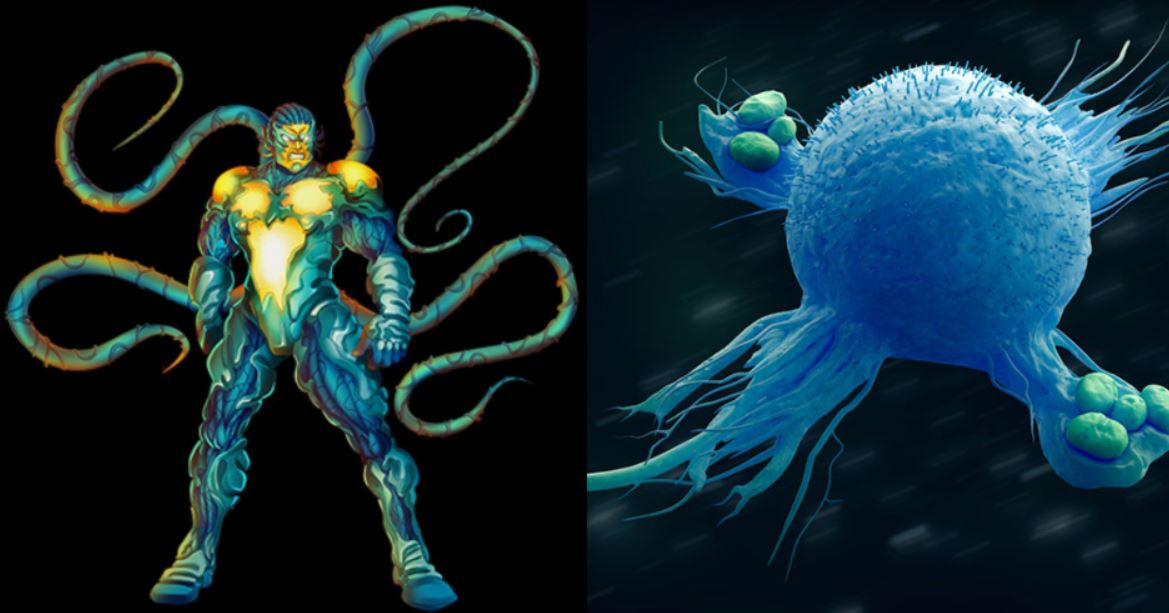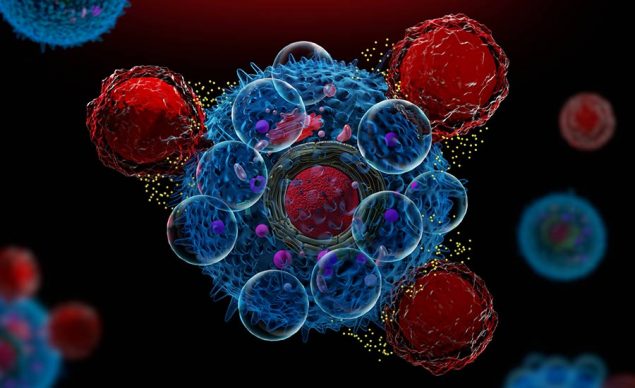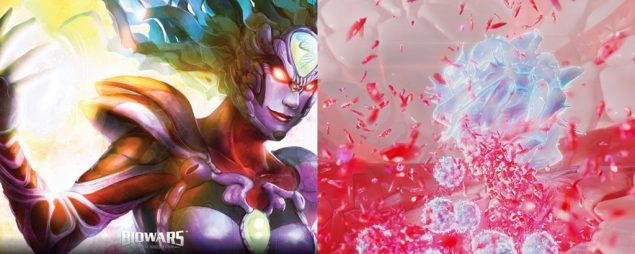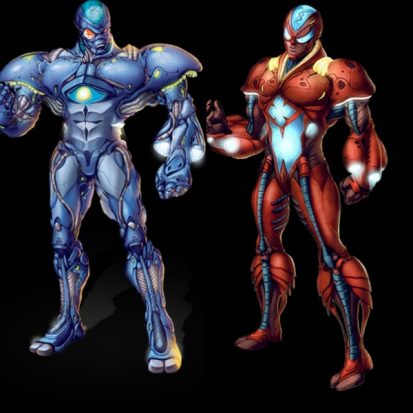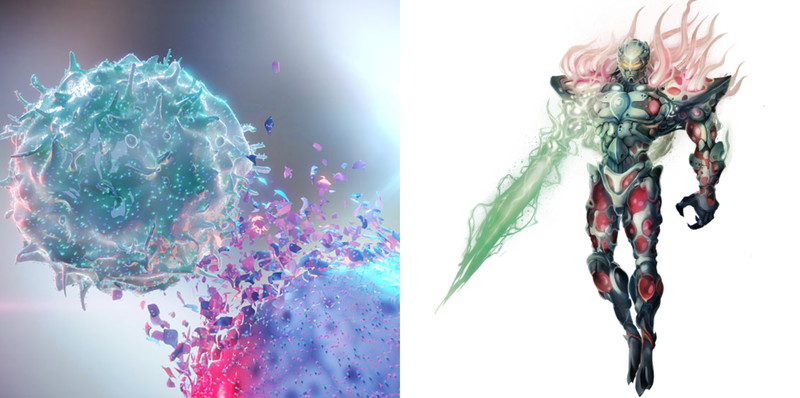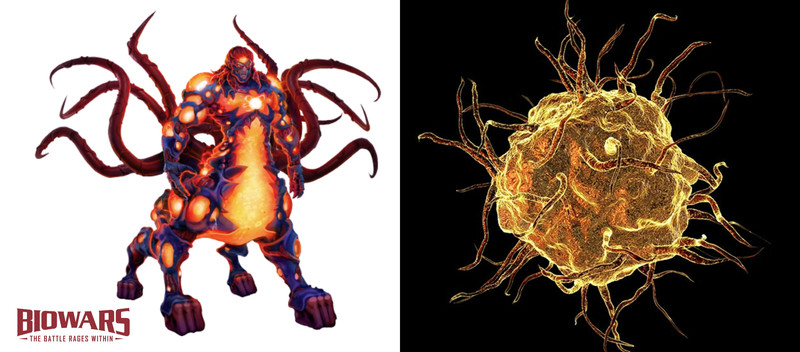Related Resources
Did you know that human macrophages are approximately 21 micrometers wide? These immune system warriors represent the biggest type of white blood cells!
In the Biowars comic book, macrophages are personified as Phagien and Scathe — the fearless warriors ready to tackle just about any mutant and microbe.
But what are macrophages exactly? What functions do they perform in our body, and how do they protect us?
Let’s find out what makes macrophages essential to our body!

What Are Macrophages?
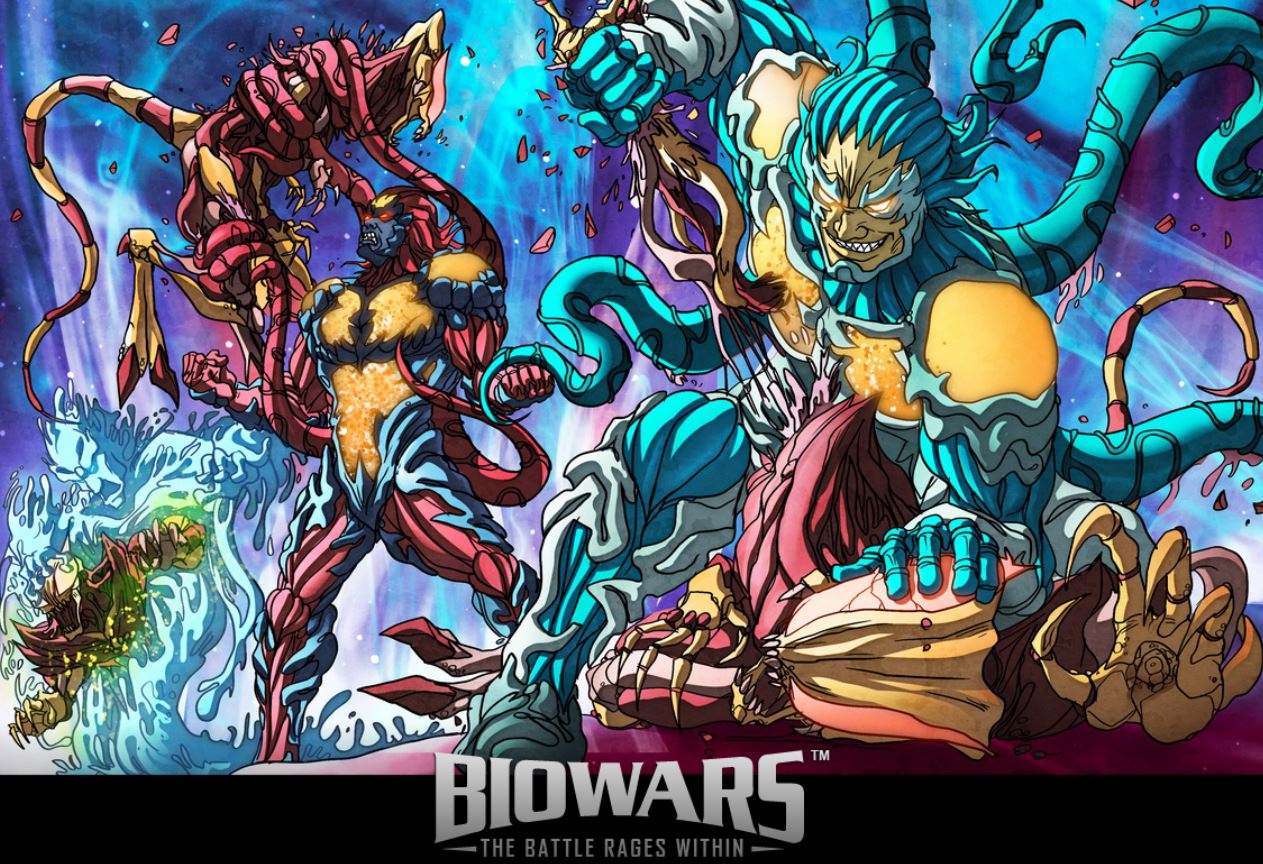
Macrophages are the “big eaters” within your immune system. Their name comes from the Greek word “makrós,” which means “large” and “phagein” — “to eat.”
Now, when we say that macrophages are big eaters, we’re talking about the “devouring the all-you-can-eat hotel buffet” kind of appetite. The hunger of other BioWarriors doesn’t even come close to that of macrophages!
As a white blood cell, macrophages have a clear goal — to keep you in good health. But unlike other white blood cells who carefully plan attacks on intruders, macrophages don’t overthink their actions. Upon detecting intruders, they immediately spur into action! Their motto is simple — seek and destroy!
Whether it’s attacking microbes and cancer cells or disintegrating cellular debris and other foreign substances, the macrophages’ primary function is to engulf, digest and purge anything that doesn’t belong inside your body. This process is known as phagocytosis.
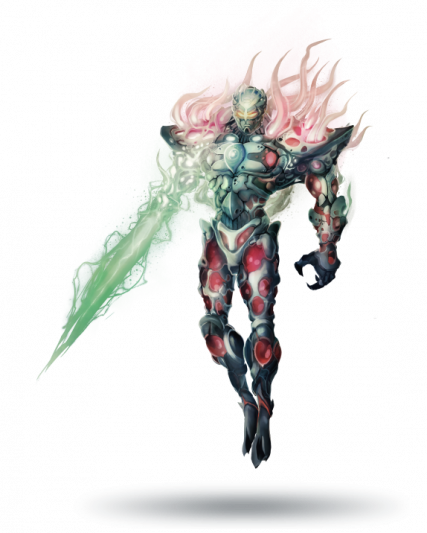
What Is Phagocytosis And How Does It Work?
Phagocytosis is a merciless act during which phagocytes devour other cells and infected agents.
Phagocytes include three types of white blood cells:
- Macrophages
- Neutrophils
- Monocytes
When a macrophage spots something that doesn’t appear to be healthy or could potentially cause some damage to the immune system, it heads out to find the suspicious agent.
Macrophages are on the lookout for certain types of proteins specific to healthy body cells. If a macrophage warrior finds such proteins on a cell, it leaves the cell alone and moves on. If it doesn’t detect the proteins on the surface of a cell, then it pulls out the forks and napkins and prepares for a virtual smorgasbord!
To make the process of phagocytosis clearer, let’s look at the image below:
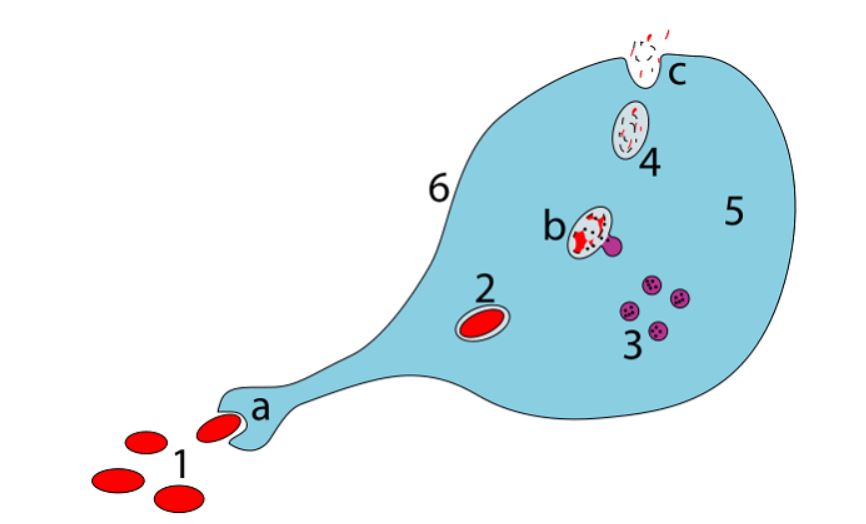
The process starts when a macrophage surrounds its prey with a mouth-like protrusion (see item “a”) that consumes pathogens (see number “1”).
Once pathogens enter a macrophage, phagosomes surround them (see number “2”). Then, phagosomes fuse themselves together with lysosomes (see number “3”) only to begin breaking them down.
The body that was formed once phagosomes and lysosomes became one is called a phagolysosome (see step “b”).
When this dynamic duo combines their powers, pathogens just don’t stand a chance! Phagolysosome’s enzymes can quickly break the enemy down (see number “4”).
At this point, what else can you expect from macrophages other than to get rid of the waste material (see step “c”) and prepare for the next course?
Not a darn thing, because that’s exactly what happens next! The waste is eliminated from the cytoplasm (see number “5”) through the cell membrane (see number “6”). From there, the bloodstream carries it away from the cell.
And that’s how phagocytosis works!
What Are The Main Functions Of Macrophages?
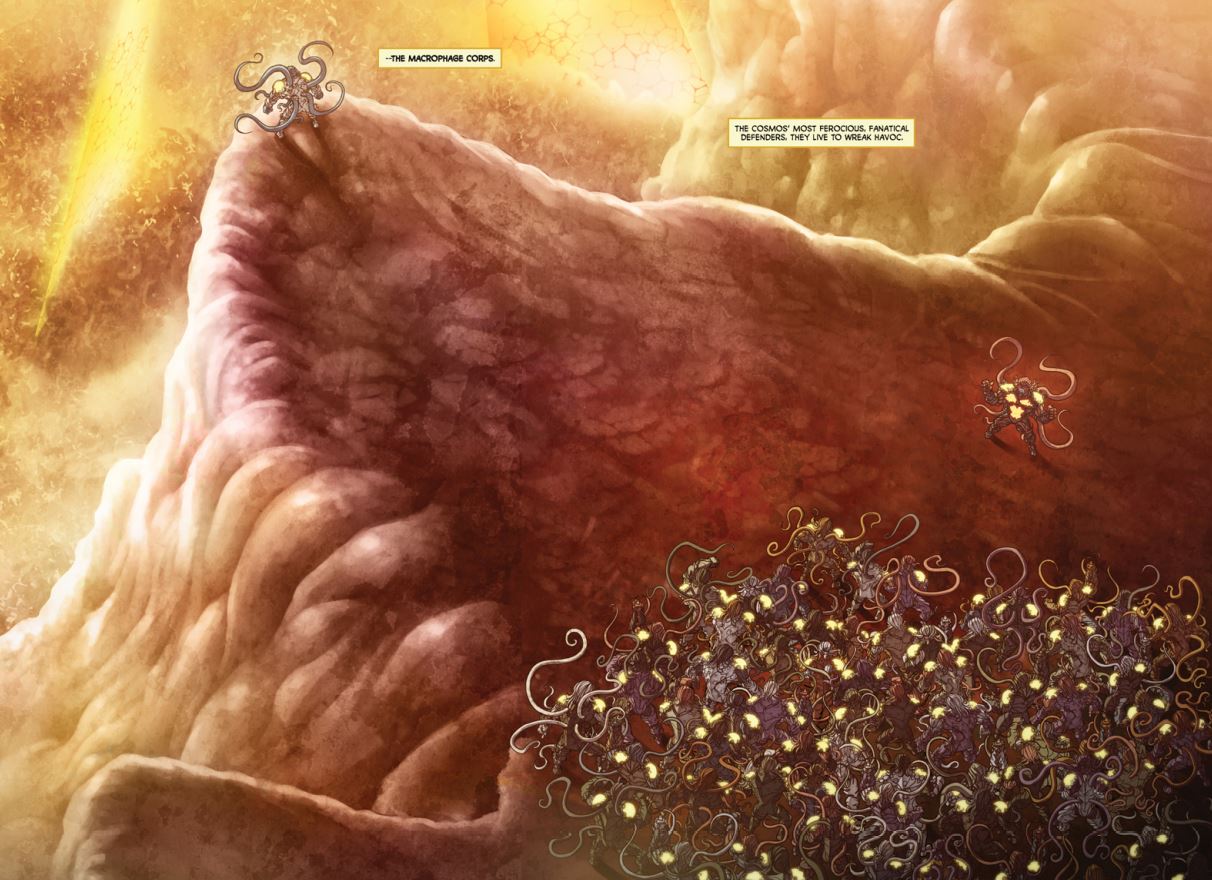
Macrophages do a lot more than just take out the bad guys. Their functions are plentiful and fascinating.
Whenever your muscles need repairing after you overuse or injure them, macrophages are there to help you regenerate your muscle fibers.
Macrophages also do a lot in terms of wound healing. They usually show up in massive numbers at the scene to lure other types of healing cells to the area, including fibroblasts. Once they all arrive at the wound, they work as a team to heal your body both from the inside and outside.
The functions of macrophages don’t end there, though. Macrophages patrol nearly every corner of your system and play a big part in your innate immune system. Alongside neutrophils and the Natural Killer Cells, they represent the first line of defense against infections.
As part of the innate immune response, macrophages team up with lymphocytes to exterminate viruses and diseases. They also release cytokines — small proteins that impact the activity of other cells. Cytokines are like biological bat signals that tell the immune system it needs to get cranking at full speed to eliminate threats!
Another interesting thing about macrophages is their ability to regenerate lost limbs in some animals, such as salamanders.
While macrophages may not be able to do this for humans yet, there’s a good chance that scientists might one day discover a way to restore parts of the body by relying on the restorative activity of macrophages.
Development And Origin Of Macrophages
Macrophages start out as special stem cells in your bone marrow called hematopoietic stem cells.
These cells turn into monocytes — a type of white blood cell that originates in your bone marrow and travels through your bloodstream.
These large cells travel all over your body via your blood vessels until they arrive at specific organs or tissues. When monocytes move into tissues, they transform into macrophages with the help of special proteins called cytokines, adjusting to the needs of the specific tissue they’re in.
This helps macrophages stay in key spots around your body, where they can fight off germs and keep tissues healthy.
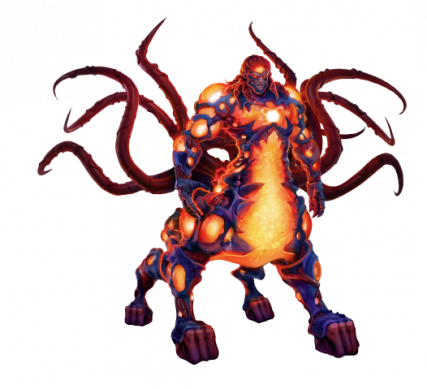
What Types Of Macrophages Exist?
If we were to compare macrophages to an insect or an animal, ants would be the best fit.
Just like ants, macrophages are small, mighty and incredibly diverse. Moreover, different types of macrophages perform different tasks to make the whole immune system work like a clock — much like ants in ant colonies.
Macrophages can be broadly categorized into two main types based on their activation states — M1 and M2 Macrophages.
M1 Macrophages
These are the “fighters” of the immune system.
They get activated when your body detects something harmful, like bacteria or viruses and they jump into action to defend you.
M1 macrophages release strong chemicals that kill germs and cause inflammation to help your body fight off infections.
M1 macrophages include:
- Alveolar macrophages: Also known as dust cells, these macrophages live within the alveoli of your lungs. Their primary responsibility is to protect your respiratory system from foreign objects, such as dust or pollen particles, bacteria and dead cells. Since your alveoli belong to your body’s primary line of defense against external hazards, alveolar macrophages outnumber other types of macrophages.
- Microglia: These glial cells are the main protectors of your central nervous system, as other cells are simply too large to find their way into your brain and spinal cord. In fact, microglia make up around 10-15% of the total number of cells in your Central Nervous System. Apart from ensuring your brain stays immune to infections, microglia also help remove dead or damaged neurons and synapses.
M2 Macrophages
M2 macrophages are the “healers.”
After the fight is over, M2 macrophages step in to calm things down.
They help repair damaged tissues and reduce inflammation by releasing healing signals that promote recovery and regeneration.
M2 macrophages include:
- Stellate macrophages: More commonly referred to as Kupffer cells, stellate macrophages are found in your liver. These cells are especially busy, as they are in charge of triggering an immune response against everything that enters your digestive system — including toxins and harmful gut bacteria.
- Red pulp macrophages: As their name suggests, these macrophages are found in the red pulp tissue of your spleen. They help regulate the primary function of your spleen — which is filtering your blood and cleaning it from dead or dysfunctional red blood cells.
- Langerhans cells: Langerhans cells are also called dendritic cells because they live across the outer layer of your skin a.k.a. epidermis. Their primary function is to inform your bacteria-fighting T cells of the impending danger — in this case, skin infections or bacterial infestations.
- Osteoclasts: Your bones aren’t as static as you might think, all thanks to osteoclasts. The primary function of these macrophages is to break down and process your bone tissue, which allows your bones to regenerate and stay healthy.
Macrophages are highly “plastic,” which means that they can shift between M1 and M2 states depending on the signals they receive from their environment. For example, microglia can act as M1 macrophages during infection but transition to M2 macrophages during recovery.
The Role Of Macrophages In Disease And Inflammation
Macrophages have two sides to their job — they can be helpful or harmful.
On the bright side, they defend your body against infections and help repair damaged tissues.
But sometimes, they can cause trouble too.
For example, in heart disease (atherosclerosis), macrophages collect in artery walls, swallowing up fats and forming clogs called plaques.
In autoimmune diseases like rheumatoid arthritis, they release too many inflammatory signals, which makes joint damage worse.
In cancer, certain macrophages (called tumor-associated macrophages) can even help tumors grow by protecting the cancer and helping it get more blood.
So, What Are Macrophages? Let’s Recap!
When we say that macrophages are among the most effective and crucial warriors of your immune system, we’re not exaggerating.
To put it simply — without macrophages, we would have a really hard time fighting off viral infections and other villains we may come across along the way.
Macrophages are not only your body’s first line of defense against bacteria, viruses and diseases. They are also responsible for some of your body’s most essential functions, including regenerating your muscles, healing your wounds, filtering your blood and more.
So next time you get a fever upon catching the flu, know that it’s simply the result of the brave macrophages alerting your immune system and a sign that your body is fighting the intruders back!
Moreover, it’s going to be exciting to see how research progresses in years to come and if scientists find a way to use macrophages to restore human tissues and organs lost to trauma.
Now that you know how powerful and important macrophages are, it’s safe to say that they are true biological heroes worth marveling at!
What Are Macrophages FAQs
Macrophages are big white blood cells that act like your body’s clean-up crew. They swallow and break down harmful invaders like bacteria and viruses through a process called phagocytosis. They also help alert other immune cells, like T-cells, to start fighting infections. Plus, macrophages release special signals (cytokines) to attract more immune cells, cause inflammation to fight germs and help repair damaged tissues.
Macrophages are found all over your body, especially in places like your lungs, liver, brain and spinal cord, skin, spleen, lymph nodes and digestive tract — they’re everywhere because that helps them keep an eye out for infections or injuries and react quickly to protect you.
When your body is healing a wound, macrophages switch to their “healer” mode, called the M2 type. They release special signals to help rebuild blood vessels and repair tissue. Macrophages also clean up germs and debris from the wound, making it easier for your body to heal.
Yes, some viruses, like HIV, can infect macrophages. In HIV infections, macrophages act as hiding spots for the virus, allowing it to keep spreading in the body.
Macrophages work with other immune cells by showing antigens to T-cells, sending signals (cytokines) to call and activate other immune cells and cleaning up dead cells.
How long macrophages live depends on where they are and what they’re doing. Macrophages in tissues can live for months, but those fighting infections or inflammation usually last only a few days to weeks.

